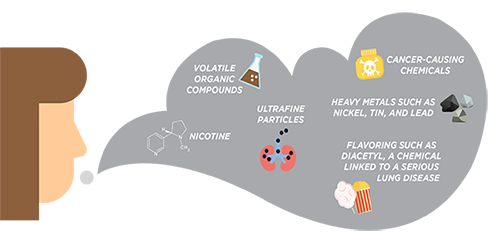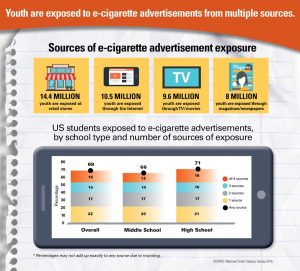Ending the Debate on JUULs
A recent report has uncovered the true effects of juuling, and the age range for those who use them, leaving many people confused and angry

Centers for Disease Control & Prevention
The CDC has released this graphic to warn E-cig users of the dangerous toxins in their vapors.
December 13, 2018
Over the past year, a strawberry scented wave has washed over the halls of high schools across America and it is all thanks to the new trend of Juuling. The e-cigarette Juul has come under fire in recent weeks after a report by the FDA linked them to cancer, causing a large outcry as the vape had found its way into the hands of teenagers. According to an article by CNN , a recent report by the US Center for Disease Control & Prevention states that 11.3% of American high schoolers admit to owning a Juul, or, roughly 1 in 10. This has been a wake-up call, depicting how substantial the problem has grown while America turned a blind eye.
The shock became anger as many began claiming that Juul was directly targeting kids by advertising flavors like vanilla creme and fruit medley. This forced Juul to launch a new campaign stating the health risks of the e-cigarette and banning many of their more childish flavors. An article by The New York Times states, “The decision by the company is the most significant sign of retrenchment by an industry that set out to offer devices to help smokers quit but now shoulders blame for a new public health problem: nicotine addiction among nonsmoking teens.”
The kids are getting addicted to the nicotine inside the Juul’s, giving them the same deadly dependency as a cigarette smoker. The danger does not stop there, however. An article by the National Center for Health and Research states, “The impact on the developing brain is of great concern. Brain imaging studies of adolescents who began smoking at a young age had markedly reduced activity in the area critical for a person’s cognitive behavior and decision making.”
One cannot ignore the fact that Juul’s do serve as one of the best ways to help smokers quit cigarettes. Juul’s don’t have tobacco which is the main component of cigarettes and one of its most deadly factors, and they do have different levels of nicotine content to regulate intake, but here, the bad simply outweighs the good.
Though well-intentioned, these revelations surrounding Juul’s impact on America’s high schoolers has left no other option other than to shut down Juul Labs for good.
Children are getting exposed to nicotine too young and it’s wreaking havoc on their brains, leaving them desperate for their next Juul rip. They are buying Juul’s to fit in without realizing what they’re really putting in their body and what it really means for them in the long-run. Kids are slowly poisoning themselves with cool mint and berry blast and it’s officially time to ask, how long are we going to wait before we finally put the Juuling epidemic to rest?



